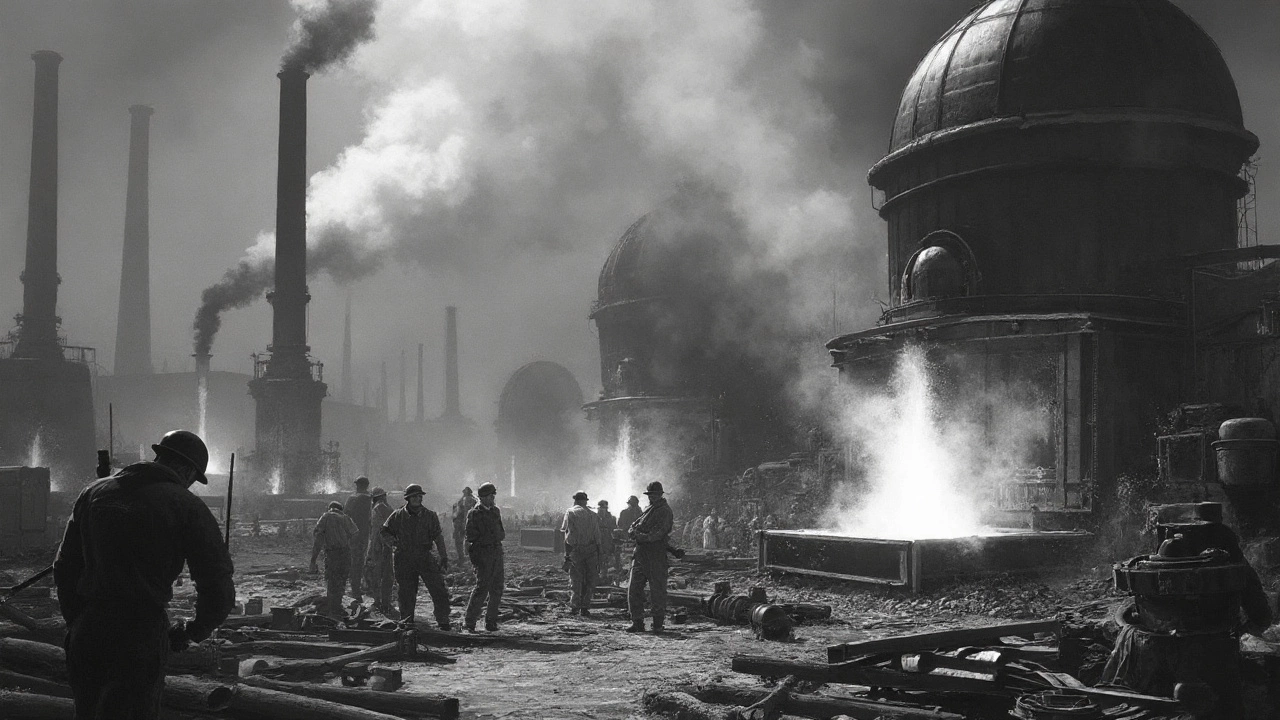Back in the 1960s, America was bossing it in the steel world. Huge mills stretched across cities like Pittsburgh, Cleveland, and Gary, churning out steel for everything from skyscrapers to muscle cars to giant ships. These places didn’t just feed America’s hunger for steel—whole neighborhoods grew up around blast furnaces. But if you drive through some of these towns today, you’ll find more rusty skeletons than roaring smokestacks. It’s a weird shift when you consider steel is still everywhere: in your car, fridge, and half the things you touch each day. So, what happened? Let’s dig into why the US isn’t the steel powerhouse it once was—and what that really means.
The Rise and Fall of American Steel
Steel and the US pretty much grew up together. After the Civil War, steel fed the railroad boom, the skyscraper craze, and all sorts of car and plane dreams. By 1950, America was making close to half the planet’s steel. But something started changing in the 1970s. While the world kept wanting more steel, the centers of steel production slowly shifted away from the US. Was it all foreign competition? Well, that’s a big piece, but it’s not everything.
For one, US steelmakers got comfortable. Older mills in places like Pennsylvania kept clinging to methods from the 1930s and 1940s. They used big, expensive blast furnaces that needed tons of workers and ate up huge amounts of energy. Meanwhile, other countries, especially Japan (and later South Korea, China, and India), built shiny new steel plants with smarter, faster, and way more efficient technology. By the 1980s, mini-mills in places like South Korea could pump out steel at less than half of American costs. Here’s the kicker: US labor costs were also way higher. Missouri steelworkers were earning triple what a similar worker made in Japan.
Take a look at this little snapshot:
| Year | US Steel Output (Million Tonnes) | China Steel Output (Million Tonnes) | US World Rank |
|---|---|---|---|
| 1970 | 120 | 18 | 1 |
| 1990 | 90 | 67 | 2 |
| 2024 | 87 | 1013 | 4 |
By 2024, China alone was making over 50% of the world’s steel. The US, once the king, had slipped to fourth place—and the spread gets bigger every year.
Why did other countries zoom ahead? Part of it is sheer modernization. Places like Japan added computer controls, electric arc furnaces, and even used recycled scrap for new steel (which is both green and cheap). While the American steel industry did eventually modernize—with companies like Nucor showing what’s possible—the giants of Pittsburgh just couldn’t keep up. Plus, when the energy crisis hit in the 1970s and 1980s, older US mills were hammered by high fuel costs. Cheap imports started flooding in, and American mills, saddled with debt and union baggage, started shutting down. Even now, in places like Pennsylvania and Ohio, folks talk about the old steel days with a mix of pride and sadness.

Can the US Still Make Steel? What It Produces Today
Here’s where things get a bit technical, but stick with me. The US does make steel—it just makes a lot less than before, and not the way your grandfather might remember. A lot of the old integrated mills, with their smokestacks and billowing steam, are gone. Instead, smaller electric arc furnace (EAF) plants dominate. These EAFs aren’t building steel from scratch (iron ore and coke); they mostly melt down old cars, refrigerators, and other scrap into new steel.
Some quick numbers: in 2023, over 70% of American-made steel came from scrap using these EAFs. This method is way cleaner and takes fewer workers, but here’s the twist—it only works if you have plenty of scrap. So, the days of America producing virgin steel from fresh iron and coal are pretty much over. Instead, American steel is about recycling.
There’s still demand for American steel, though. Specialty steels, like the ultra-strong stuff used in aerospace or defense, are still mostly made here because quality control is king. A lot of US steel now goes into construction, pipelines, and the remnants of the auto industry. Car makers like Ford and GM still source some steel domestically, especially if they want to slap a “Made in America” label on their trucks.
But for bulk orders—the giant beams for skyscrapers or basic sheet metal? A ton comes from overseas. You might be surprised to find out that nearly a quarter of the steel used in the US is imported, mostly from places like Canada, Brazil, South Korea, and Mexico. Of course, trade rules, tariffs, and politics play a part. Former President Trump slapped tariffs on imported steel in 2018, hoping to help US steelmakers bounce back. Did it work? A little, but not enough to spark a full comeback. Companies like US Steel have cut thousands of jobs even as their profits bounced up and down.
One thing to remember: American steel isn’t dead, it’s just different. It switched from being about mass production to niche, high-quality, and recycled products. Some folks see this as smart, playing to strengths. Others see it as a loss of industrial might. My uncle worked nineteen years at a plant outside Youngstown, then watched it close in ‘92. Now he fixes vending machines and jokes that’s the future of manufacturing. He’s only half kidding.

What Would It Take to Bring American Steel Back?
This is the big question, right? Every election cycle, “bringing steel jobs back” is a hot promise. In reality, it’s a lot tougher than it sounds. First, those old mills aren’t just turned off—they were demolished, making way for shopping malls, condos, or just empty fields. Building new ones costs billions, and only makes sense if you have a steady, strong demand. Right now, that demand just isn’t there, especially with the world awash in cheap steel from China.
Also, labor costs in the US are still higher than in many other countries. Even with the newest technology, wages, health insurance, and pensions add up. American workers earn around $35 an hour on average, which crushes companies trying to compete with plants in Southeast Asia where wages can be a quarter of that. Automation could change some of that, but robots don’t buy houses or groceries in steel towns the way people do.
There’s also the environmental angle. Classic steelmaking is dirty—lots of carbon emissions, water pollution, and mountains of slag as waste. Regulators in the US enforce stricter rules than most countries. This makes it costly to fire up new blast furnaces on American soil. That’s partly why companies here focus on EAFs because recycling steel produces much less pollution. It’s one green upside to the decline.
So, is there hope for an American steel boom? Maybe in a new form. Some US firms are experimenting with even cleaner technologies, like hydrogen-based furnaces. There’s talk of turning old mill sites into so-called “green steel” hubs—powered by wind, solar, or even nuclear energy. The government is throwing cash at research grants and tax breaks to encourage this. And people are waking up to supply chain issues. The pandemic and its fallout taught everyone a lesson—when other countries close borders or supply lines get clogged, having your own steel supply becomes a national security issue. Suddenly, “Made in America” is more than a marketing slogan—it’s about not being caught off guard.
The world of steel is on the move. China makes the most, but even there, regulators are starting to clamp down on pollution. Maybe the race for cleaner, better, smarter steel will give American mills another chance to shine. But it probably won’t look like the steel world your grandfather remembers. It’ll be cleaner, smaller, and more high-tech. Whether that’s enough to revive the towns that made steel famous is another story.
So, does the US still make steel? Yeah, just a lot less—and in a different, greener way. Will it ever make as much as it did in the glory days? Probably not. But watch this space, because the game isn’t over just yet.
